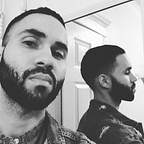ORLAN: BEFORE TRANSHUMANISM
ORLAN is a French multi-media conceptual artist. Her work raises twenty-first-century questions about beauty standards and their effect on the human body. She produces work in different mediums, such as sculpture, photography, and performance. She is most famous for her performances in which she used surgery as a medium to modify her body. Before beginning her transformation, she used anthropological, religious, and psychological texts as a base to understand and deconstruct the identity given to her by nature and society.
She also created performance pieces based on Baroque iconography for more than a decade. Many of her images during that period focused on the two great female stereotypes promulgated by Christianity; Mary the Mother and Mary the prostitute. From this work, she began the process of “Renaissance” and “Re-birth” as she called it. She used surgery and the operating room to leave behind that given identity and create a new one. The whole process was documented in a reportage called “Carnal Art.”
“Carnal Art is self-portraiture in the classical sense, but realized through the possibility of technology. It swings between defiguration and refiguration. Its inscription in the flesh is a function of our age. The body has become a “modified ready-made”, no longer seen as the ideal it once represented ;the body is not anymore this ideal ready-made it was satisfying to sign.”
— ORLAN Carnal Art Definition
The performances using surgery helped ORLAN pioneer a new attitude towards the body that has now reached a mass audience through philosophies like trans and post-humanism. And through personalities like the Futurist and inventor Ray Kurzweil and Gerontologist Aubrey De Grey. Her medium was plastic surgery, theirs are chemicals, genetic therapies, and biotechnology. But they share the same aim and understanding: the body is (at least in the abstract sense) no longer a set reality. We now seek to change and transform it. The body as a given unchangeable entity and identity is now obsolete.
During the documentary, ORLAN shows us that the desire to transcend is nothing new. Every human civilization has created different beauty standards. These rules result in the creation different bodies through fashion and body modification. The desire to defy nature is something inherent in us. We began this journey by naming and categorizing the world. Once we defined it, it ceased to be a mystery. We then explained it through myth and religion. This allowed us to live and thrive without fear in the vastness and danger of nature. We continue this process even today through agriculture, dress, architecture, science, and medicine.
For early human civilizations transcendence was only possible in the abstract. Religion and myth provided the cosmic hope of living after the natural decay of the body. ORLAN’s performances go even further. She transcends by creating her own physical image in the operating room. Her creation is not a victory. She still depends on nature’s whims because she can die. But her work manifests or at least creates a platform for the trans and post-human rejection of nature through body modification, and augmentation. In other words, ORLAN dwells in the realm of representation, identity, and perception. And these movements dwell in the realm of augmentation, life extension, and ultimately inherent or absolute change from the human to something else.
Both of these approaches question the beauty standards created by our Judeo-Christian culture. ORLAN violates the sacred Christian dictum which states that the body must not be touched. Today this attitude is being depicted in films such as Lucy and Transcendence. It is being implemented through technology aimed to combat aging and disease. It goes even further by attempting to augment current human capabilities and elongating lifespans.
Her work is still however very relevant because it attempts to have a dialogue that the trans-human and post-human movements do not seem to be concerned with. She teaches us that we can shed the natural and societal identities placed upon us by our cultural traditions. She also questions whether our approach to new technologies by asking whether we will perpetuate the same beauty standards that we have now or if we will use them to push or even break those standards? She, of course, opts for the latter, but most of society today doesn’t. Most people use surgery to maintain or enhance themselves not to experiment with their identities. As new bio-technologies and genetic engineering emerge the answers to these questions will become more and more pressing.
